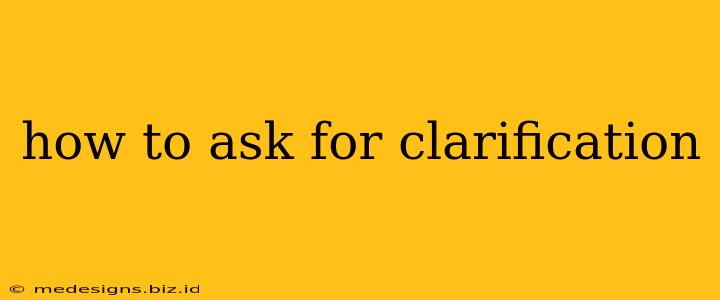How to Ask for Clarification: A Guide to Effective Communication
Asking for clarification is a crucial skill for effective communication, whether in personal relationships, professional settings, or online interactions. It shows you're engaged, prevents misunderstandings, and fosters stronger connections. However, knowing how to ask for clarification effectively is key. This guide will equip you with the strategies and phrasing you need to confidently seek clarification in various situations.
Why Ask for Clarification?
Before diving into the how, let's understand the why. Asking for clarification isn't about appearing incompetent; it's about ensuring you fully understand the information presented. Benefits include:
- Preventing misunderstandings and errors: Misinterpretations can lead to costly mistakes, both professionally and personally.
- Building stronger relationships: Showing you're attentive and seeking understanding strengthens trust and rapport.
- Improving efficiency: Clarifying ambiguous instructions saves time and resources in the long run.
- Demonstrating active listening: Asking clarifying questions indicates you're actively engaged and invested in the conversation.
- Promoting learning and growth: Seeking clarification shows a willingness to learn and improve your understanding.
How to Ask for Clarification: Techniques and Phrases
The best way to ask for clarification depends on the context. However, some general principles apply:
- Be polite and respectful: Always maintain a courteous tone, even when dealing with confusing information.
- Be specific: Avoid vague questions. Clearly identify the specific part you need clarification on.
- Use "I" statements: Focus on your own understanding rather than blaming the other person. For example, "I'm a little confused about..." instead of "You're not being clear..."
- Choose the right medium: Consider the context. A quick email might suffice for a minor query, whereas a phone call or in-person conversation might be better for more complex issues.
- Ask open-ended questions: Encourage detailed responses rather than simple "yes" or "no" answers.
Here are some phrases you can use:
General Clarification:
- "Could you please clarify...?"
- "I'm not entirely sure I understand. Could you explain that again?"
- "I'm a little confused about [specific point]. Could you elaborate?"
- "To make sure I understand correctly, are you saying...?"
- "Could you give me an example of...?"
Clarifying Instructions:
- "I'm having trouble following the instructions for [specific task]. Could you walk me through it again?"
- "Could you explain the steps involved in more detail?"
- "I'm unsure about [specific step]. Could you clarify how to proceed?"
Clarifying Feedback:
- "I appreciate your feedback. Could you provide some specific examples to help me understand better?"
- "I'm not sure what you mean by [specific comment]. Could you explain further?"
- "To help me improve, could you elaborate on what I could do differently?"
Online Interactions:
When seeking clarification online, use emojis or other visual cues to convey your tone and intention. For example, a simple question mark (?) or a slightly apologetic emoji can help soften your query.
Examples in Different Contexts:
- Workplace: "I'm unsure about the deadline for the Johnson project. Could you clarify when the final report is due?"
- Personal Relationship: "I'm a little confused about your plans for the weekend. Could you explain them again?"
- Educational Setting: "I'm having trouble understanding the concept of [subject matter]. Could you provide another example?"
Overcoming the Fear of Asking for Clarification
Many people hesitate to ask for clarification due to fear of appearing incompetent or bothering others. Remember, it's much better to ask and understand than to proceed with incorrect information. Your willingness to clarify demonstrates professionalism and a commitment to accuracy. Embrace the opportunity to learn and improve communication skills.
By using these techniques and phrases, you can confidently ask for clarification in any situation, leading to clearer communication and stronger relationships. Remember, seeking understanding is a sign of strength, not weakness.
